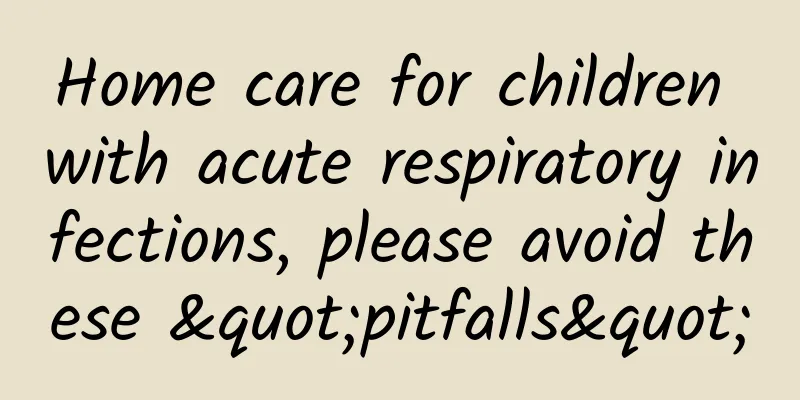Home care for children with acute respiratory infections, please avoid these "pitfalls"

|
This is the 4765th article of Da Yi Xiao Hu This autumn and winter, with the temperature fluctuating, many parents of children are worried from time to time: their children have repeated fevers, runny nose, sore throat, and coughs. They have been treated with medication for a short time, and they are "knocked down" again without paying attention; from influenza virus infection to Mycoplasma pneumoniae infection, some have even caused pediatric bronchitis and pneumonia. The treatment and home care of pediatric acute respiratory tract infection has become one of the focuses of parents' attention recently. Pediatric acute respiratory tract infection is the most common acute disease in children. It mainly invades the nasal cavity/sinus and pharynx of the upper respiratory tract, causing acute rhinitis/sinusitis, acute pharyngitis/pharyngitis, and acute tonsillitis; or invades the trachea, bronchi at all levels, and alveoli of the lower respiratory tract, causing acute bronchitis, peribronchitis, pneumonia, etc. For preschool children, since they are often unable to clearly express the specific location, characteristics, degree and changes of discomfort, parents need to pay more attention to observe some of their external manifestations, such as: body temperature, complexion, whether the skin is moist or dry (sweating or not), crying and restlessness/mental depression, appetite, vomiting, defecation and urination, etc. In addition, parents' concern for "the disease is in your body, the pain is in my heart", some parents will inevitably rely more on their own subjective wishes and judgments in caring for their children, or follow some so-called "traditional experience" and "rumors" passed down by word of mouth, resulting in wrong practices. Next, let us analyze several common home care misunderstandings that are not conducive to the recovery of children with acute respiratory infections. 1. Common Misunderstandings Misconception 1: When a child has a fever, he should try to wear more clothes to warm up the sweat so that he can recover faster! Error Analysis Although catching a cold is often the trigger for acute respiratory infections in children, and sweating after a fever can lower the body temperature, adding too much clothing and over-wrapping can hinder skin breathability and sweat evaporation, and may also cause skin eczema, making children feel more uncomfortable. Excessive sweating and damp underwear may cause children to catch a cold again, causing recurrence of the disease. Care recommendations Dress your child appropriately, with the neck and back warm and sweat-free. If the temperature difference between day and night is large, follow the "onion dressing method", that is, replace a single thick cotton jacket/pants with a combination of multiple layers of clothing, and appropriately reduce or add one or two layers of clothing as the ambient temperature rises or falls, so as to achieve the most appropriate warmth effect mentioned above. In addition, attention should be paid to keeping the head and feet, which are easy to dissipate heat, warm. If the child has a high fever, dress the child in loose and breathable clothing. When sweating is obvious, dry the skin in time and change underwear frequently. Misconception 2: In order to make the child's illness get better quickly, commonly used medicines are used in rotation, or when symptoms recur, the medicine is used for a longer period of time or in larger doses. Error Analysis Some parents of children with acute respiratory infections get nervous when they see fever, thinking that "if the fever continues, pneumonia will develop." They think that the first measure is to reduce fever, so they use one medicine that does not reduce fever immediately, then use another, and take turns using commonly used over-the-counter Chinese and Western medicines for treating colds and fever. In fact, these parents have reversed the cause and effect relationship. Fever is a manifestation of the body's immune response after viral or bacterial infection. Only when the infection is controlled can the body temperature truly return to normal. Simply reducing fever is not a targeted treatment measure and does not help control the infection itself. Many commonly used over-the-counter drugs for relieving cold symptoms have similar ingredients and similar effects. They are all compound preparations composed of some antipyretic, analgesic, antitussive, nasal mucosal vascular constriction, anti-allergic and other drug ingredients; some commonly used Chinese patent medicines also contain drugs with similar effects or contain the same drug. If two or three similar drugs are used in a short period of time, it will not only be unhelpful to control the disease, but the dosage exceeding the safety limit may cause damage to the child's liver and kidney function, which is really undesirable. . Another situation that needs to be avoided is that some parents, when they see that their children's fever or nasal congestion/runny nose, sore throat, cough and other respiratory symptoms have not improved two or three days after starting to take relevant over-the-counter drugs, subjectively believe that the treatment course or dosage is insufficient, and still insist on giving these drugs or even increasing the dosage. This may not only delay the timely assessment of the child's condition, but also increase the risk of adverse drug reactions. Care recommendations Generally, when the child's temperature exceeds 38.5℃, antipyretics can be given (children with a history of febrile convulsions or epilepsy can use antipyretics when the temperature reaches around 38℃). When the temperature is below 38.5℃ or the child has a fever again within 8 hours of taking antipyretics, physical cooling can be used: a fever patch can be applied to the forehead, or an ice pack can be used (wrap the ice pack with a dry towel and place it on the child's pillow, armpit, or groin). After using physical cooling, re-measure the temperature every half an hour to an hour, and remove the fever patch/ice pack in time when the temperature drops below 38℃. After the initial drug treatment at home, if the child's symptoms do not significantly improve within 48 hours, or even tend to worsen or new symptoms appear, go to the hospital for treatment in time. Myth 3: If children cough for a long time, they will develop pneumonia, so they should take more cough suppressants. Error Analysis Acute pharyngitis, acute tonsillitis, acute bronchitis, pneumonia, nasal secretion backflow irritating the pharynx and airway, accompanied by airway allergic reactions, etc. can all cause cough. It is difficult to judge whether it is pneumonia based on the duration of cough symptoms alone, and cough is not the cause of pneumonia. Excessive use of cough suppressants (such as dextromethorphan) may inhibit the expectoration function of the bronchi, which is not conducive to the repair of the airway mucosa and alveolar surface. Care recommendations According to the possible causes of cough, use the corresponding medicine or medicine containing the corresponding ingredients. It is not only antitussive drugs that can relieve cough symptoms. For example, due to increased nasal secretions, especially when lying flat, the nasal secretions flow back to stimulate the throat or trachea and cause cough, which is often similar to choking cough. By taking medicines containing components that shrink the blood vessels of the nasal mucosa (pseudoephedrine) or using nasal drops locally, the runny nose is reduced and the cough is relieved accordingly; sometimes cough is caused by inflammation of the pharynx. By using Chinese patent medicines containing heat-clearing and detoxifying ingredients to reduce pharyngeal congestion, exudation and other inflammatory reactions, the cough is also relieved accordingly; in bronchitis or pneumonia, poor discharge of secretions is one of the main causes of cough. The use of drugs that promote sputum dilution and discharge (such as ambroxol) can relieve cough symptoms. When parents initially give their children cough medicines for about 2 days during home care and the effect is not obvious, they should take their children to see a doctor in time and ask medical staff to evaluate the child's condition and provide professional diagnosis and treatment advice and nursing guidance. Misconception 4: If a child has a fever and is listless, he or she should eat more, supplement nutrition, eat more meat, eat more cheese... Error Analysis Children's digestive systems are relatively fragile, and they are more significantly affected than adults during acute respiratory infections. Fever can weaken children's digestive function and cause mild indigestion symptoms such as decreased appetite and flatulence. When some young children cough violently, they may suffer from diaphragmatic spasms (hiccups), gastric spasms (stomach pain), vomiting, etc. due to repeated increases in abdominal pressure and frequent and intense diaphragm movements. Some viruses that cause respiratory infections (such as influenza B virus) may also directly cause gastrointestinal reactions such as vomiting and diarrhea. Therefore, during children's acute respiratory infections, supplementing too much high-protein, high-fat food will only increase the burden on the child's digestive system, and even cause digestive system complications, which is not conducive to the recovery of the disease. Care recommendations ① Adopt a “small and frequent” diet, that is, eat about 1/3 to 1/2 of the usual amount of food each time, and eat/feed every 2-3 hours to reduce the gastrointestinal burden and prevent the increase of gastrointestinal and intra-abdominal pressure. ② Adopt a semi-liquid diet to facilitate digestion and absorption of nutrients, and avoid foods containing more insoluble crude fiber, such as leeks, enoki mushrooms, bamboo shoots, etc.; the main way to process food should be steaming and boiling, and avoid frying and grilling. ③The food types should mainly be fresh fruits and vegetables, grains, soy products, mushrooms, etc., with a small amount of animal protein food, and avoid high-sugar, high-fat, high-salt, spicy and pickled foods. 2. Other home care tips 1. Keep the indoor air fresh and well-circulated, open windows for ventilation at least 3 times a day, each time for at least 30 minutes; the environment in which the child rests should be kept quiet and of appropriate brightness. 2. Parents should accompany their children while avoiding passing on negative emotions such as anxiety to their children. For example, they should not repeatedly ask their children whether their symptoms have improved. They can relieve their children's discomfort by diverting their attention and try to avoid letting their children cry repeatedly and aggravating local symptoms. 3. Replenish water and encourage the child to drink more water (small amounts and multiple times). This can not only help reduce fever, but also prevent dehydration. It can also dilute sticky sputum and make it easier to cough up. 4. Humidifiers can be used appropriately indoors to help relieve children's symptoms such as nasal congestion, dry nose, dry throat, and thick sputum that is difficult to cough up. Author: Shuguang Hospital Affiliated to Shanghai University of Traditional Chinese Medicine Pei Lei, head nurse of the emergency department |
<<: What problems need to be solved in building a lunar base?
>>: Nutritional comparison of 22 kinds of nuts, you will never guess the first one!
Recommend
How can brands achieve growth in 2020?
Let’s first think about the following questions: ...
Orange high temperature warning! The highest temperature in many places can reach above 37℃. How to deal with the "burning" test?
The Central Meteorological Observatory continued ...
The most comprehensive analysis of headline information flow advertising! Delivery tips included!
As the largest information flow platform at prese...
This is the real "death by light"! They are "as if they are facing a formidable enemy" when they see the moonlight丨Nature Trumpet
This is the 68th issue of the Nature Trumpet colu...
Tencent still needs to rely on third parties to support WeChat
At the Tencent Global Partner Conference held two...
Exposing the blackmail of 21st Century News: illegally collecting hundreds of millions of yuan in protection fees
"The media is a kind of public power. If tho...
How to increase the popularity of the live broadcast room? How to retain people in short video live broadcast rooms?
There are thousands of problems for newcomers in ...
Deloitte released a report at the Bund Conference: It is expected that mobile consumption in Asia will more than triple by 2025 compared to 2019
This morning, Deloitte released a report titled &...
Team collaboration and MVVM architecture design in iOS
I wrote this article today to serve as a starting...
The operation logic of Zhihu and Douban communities!
Let me start with the definition: a community is ...
In the search promotion cooperation of Baidu Alliance, if a user clicks on 1,000 ads, how much money can the website owner earn? Assuming 30 percent,
First of all, you asked the wrong question. There...
Apple iOS 15.2 fixes remote jailbreak vulnerability: hackers can crack iPhone in 1 second
[[441084]] Apple recently pushed the official ver...
Perfect World Novel Free Reading Full Text: Is it necessary to promote the website during the holidays?
For many webmasters and enterprises, before the h...
How did Chen Danian create an application as large as WeChat by working only 6 hours a day?
As a tool product that already has 900 million us...
【Creative Cultivation Program】In fact, it is your stomach that controls your brain!
Author: Chen Wen Reviewer: Associate Professor Ta...









